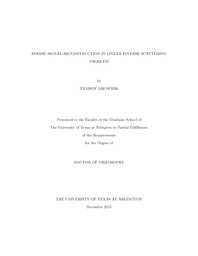
ATTENTION: The works hosted here are being migrated to a new repository that will consolidate resources, improve discoverability, and better show UTA's research impact on the global community. We will update authors as the migration progresses. Please see MavMatrix for more information.
Show simple item record
| dc.contributor.advisor | Oraintara, Soontorn | |
| dc.creator | Bhowmik, Tanmoy | |
| dc.date.accessioned | 2016-01-26T22:33:02Z | |
| dc.date.available | 2016-01-26T22:33:02Z | |
| dc.date.created | 2015-12 | |
| dc.date.issued | 2015-12-09 | |
| dc.date.submitted | December 2015 | |
| dc.identifier.uri | http://hdl.handle.net/10106/25429 | |
| dc.description.abstract | Proper mathematical modeling of inverse scattering problem is of utmost importance in applications such as optical imaging and microscopy, radar, acoustic, seismic and medical imaging. However, the problem is non-linear and ill-posed due to the diffusive nature of wave propagation through the scattering medium. Born and Rytov approximation are two widely used techniques to linearize the inverse scattering problem that simplifies the mathematics and modeling of wave propagation through scattering medium in special cases. The linear inverse scattering problem is still severely ill-posed and hence, in general, the solution is not stable and unique, unless a priori knowledge about the solution is used to regularize the inverse problem. In many of the inverse scattering problem it is known a priori that the object to be imaged is sparse in spatial domain or in some transform domain. In such cases, regularization techniques that impose sparsity of the solution should be used. The focus of this dissertation is sparsity regularization of the linear inverse scattering problem. The major contributions can be divided in two segments: (i) Investigate the condition of uniqueness for the sparsity regularized linear inverse scattering problem and (ii) Propose a dimensionality reduction based optimization method for rapid and high resolution sparse image reconstruction for the inverse scattering problem in optical imaging.
After studying the scattering wave measurement process and the nature of the inverse problem, the condition for obtaining a unique sparsest solution of the linear inverse scattering problem is derived. The condition is based on the degree of sparsity of the image for a fixed source-detector geometry. This result will be useful to determine when one can use Born/Rytov approximation reliably for inverse
scattering problem. Computer simulations and laboratory phantom experiments are performed and state-of-the-art sparse signal reconstruction scheme is used to reconstruct the solution. The results show that the quality of reconstruction is satisfactory within the derived sparsity limit.
In the second part of this dissertation, a novel optimization scheme is proposed to solve a particular instance of inverse scattering problem, namely, diffuse optical tomography (DOT), which is a promising low cost and portable imaging modality. Conventional sparse optimization approaches to solve DOT are computationally expensive and have no selection criteria to optimize the regularization parameter. A novel algorithm, Dimensionality Reduction based Optimization for DOT (DRO-DOT), is proposed in this research. It reduces the dimensionality of the inverse DOT problem by reducing the number of unknowns in two steps and thereby makes the overall process fast. First, it constructs a low resolution voxel basis based on the sensing-matrix properties to find an image support. Second, it reconstructs the sparse image inside this support. To compensate for the reduced sensitivity with increasing depth, depth compensation is incorporated in DRO-DOT. An efficient method to optimally select the regularization parameter is developed for obtaining a high-quality DOT image. DRO-DOT is also able to reconstruct high-resolution image even with a limited number of optodes in a spatially limited imaging set-up which leads towards further application in in-vivo prostate DOT imaging | |
| dc.format.mimetype | application/pdf | |
| dc.language.iso | en_US | |
| dc.subject | Diffuse optical tomography | |
| dc.subject | Compressed sensing | |
| dc.title | SPARSE SIGNAL RECONSTRUCTION IN LINEAR INVERSE SCATTERING PROBLEM | |
| dc.type | Thesis | |
| dc.date.updated | 2016-01-26T22:33:03Z | |
| thesis.degree.department | Electrical Engineering | |
| thesis.degree.grantor | The University of Texas at Arlington | |
| thesis.degree.level | Doctoral | |
| thesis.degree.name | Doctor of Philosophy in Electrical Engineering | |
| dc.type.material | text | |
Files in this item
- Name:
- BHOWMIK-DISSERTATION-2015.pdf
- Size:
- 7.389Mb
- Format:
- PDF
This item appears in the following Collection(s)
Show simple item record


